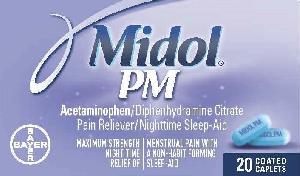Midol PM Interactions
There are 561 drugs known to interact with Midol PM (acetaminophen/diphenhydramine), along with 11 disease interactions, and 2 alcohol/food interactions. Of the total drug interactions, 23 are major, 523 are moderate, and 15 are minor.
- View all 561 medications that may interact with Midol PM
- View Midol PM alcohol/food interactions (2)
- View Midol PM disease interactions (11)
Most frequently checked interactions
View interaction reports for Midol PM (acetaminophen / diphenhydramine) and the medicines listed below.
- Adderall XR (amphetamine / dextroamphetamine)
- Amitiza (lubiprostone)
- Belviq (lorcaserin)
- Calcium 600 D (calcium / vitamin d)
- clonazepam
- Concerta (methylphenidate)
- Contrave (bupropion / naltrexone)
- CoQ10 (ubiquinone)
- Depakote ER (divalproex sodium)
- dexamethasone
- duloxetine
- Flovent HFA (fluticasone)
- hyoscyamine
- Iron Sulfate (ferrous sulfate)
- Lamictal (lamotrigine)
- lorazepam
- melatonin
- Midol Complete (acetaminophen / caffeine / pyrilamine)
- Mucinex (guaifenesin)
- Mucinex Sinus-Max Day & Night (Night) (acetaminophen / diphenhydramine / phenylephrine)
- omeprazole
- ondansetron
- Ortho-Novum 1 / 35 (ethinyl estradiol / norethindrone)
- ProAir HFA (albuterol)
- promethazine
- Risperdal (risperidone)
- Robaxin-750 (methocarbamol)
- triazolam
- Tylenol (acetaminophen)
- Vitamin C (ascorbic acid)
Midol PM alcohol/food interactions
There are 2 alcohol/food interactions with Midol PM (acetaminophen / diphenhydramine).
Midol PM disease interactions
There are 11 disease interactions with Midol PM (acetaminophen / diphenhydramine) which include:
- alcoholism
- liver disease
- depression
- PKU
- anticholinergic effects
- asthma/COPD
- cardiovascular
- renal/liver disease
- glaucoma
- liver disease
- resp depression
More about Midol PM (acetaminophen / diphenhydramine)
- Midol PM consumer information
- Compare alternatives
- Reviews (2)
- Drug images
- Side effects
- Dosage information
- During pregnancy
- Drug class: analgesic combinations
- En español
Related treatment guides
Drug Interaction Classification
| Highly clinically significant. Avoid combinations; the risk of the interaction outweighs the benefit. | |
| Moderately clinically significant. Usually avoid combinations; use it only under special circumstances. | |
| Minimally clinically significant. Minimize risk; assess risk and consider an alternative drug, take steps to circumvent the interaction risk and/or institute a monitoring plan. | |
| No interaction information available. |
See also:
Further information
Always consult your healthcare provider to ensure the information displayed on this page applies to your personal circumstances.


